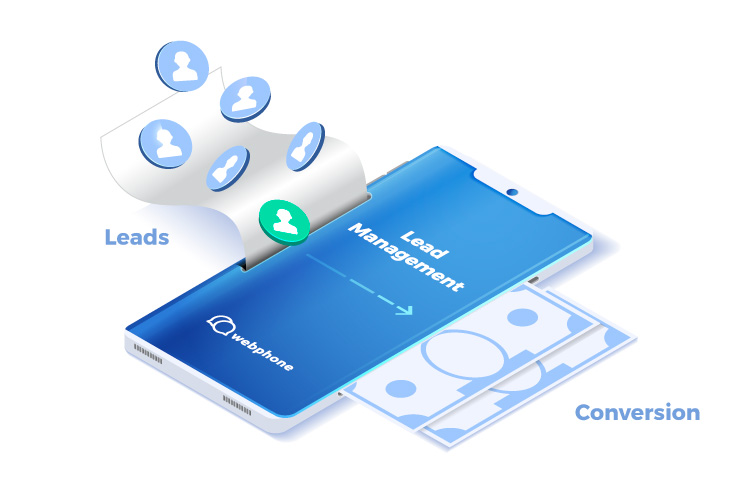In today’s swamped and competitive marketplace, lead generation is the starting point for business to increase their chances to gain customers.
Because of that, many companies focus their efforts on acquisition and although we cannot deny that a well-defined marketing strategy can generate a high volume of leads, the result is not always translated into an increase in sales.
This is highly due to a mismanagement of these leads, which arouse an initial interest in our products but we finally failed to convert.
Therefore it is clear that the leads generation is not useful if you don’t properly manage those potential customers.
If you want to transform your leads into sales, allowing your business to grow, it is imperative to follow a proper lead management strategy.
In this post we will inform you about the lead management and everything you need to know.
Let’s get started!
What is the lead management?
When we talk about leads, we allude to those visitors to our website who at some point have expressed their interest in our products or services and have left us their personal data.
From this moment on, they become contacts, with whom we will be able to maintain communication in order to guide them through the sales funnel.
Obtaining leads will be, therefore, the first step that will allow us to increase our database of potential customers. However, once we have collected the contact details, we must effectively manage and optimize those processes aimed at achieving the conversion, bearing in mind that not all leads are the same, or their interaction with our brand.
That is why it is so important to carry out a successful lead management, which allows us to provide positive experiences to every potential customer that meets their needs according to the moment in which they are in the sales cycle.
We can define lead management as the set of strategies, actions and tools aimed at identifying which contacts are convenient opportunities for marketing actions and which of them are prepared for selling.
Although lead management may appear a simple thing, there are many companies without the appropriate guidelines or means to effectively manage their contacts.
If you have a similar problem and you are interested in taking advantage of the full potential of your leads, you are in the right place.
Below, we will give you the keys to an effective and successful lead management process.
Lets go!

Lead Management Stages
Now we know what lead management is, it is time to analyse the stages of the process a contact goes through, before being ready to sell:
1. Lead generation:
The lead generation is the process of attracting and converting the visits to your website into contacts interested in our company’s products and services.
The design of a well-defined acquisition strategy will allow us to nurture our database with quality leads and ensure a higher return on investment.
If you want to know more about the lead generation, we invite you to read our post “Eight efficient techniques to improve lead generation from your website”
2. Lead enrichment:
During the lead generation process, traffic can come to us through different tools and channels.
To streamline our business work flows, it is important to ensure that each lead is automatically sent to the CRM system; furthermore, the act of enriching every lead with useful information will help our marketing and sales teams to better understand the interests of the potential customers.
We can enrich our leads, adding to the known information (name, email, telephone), other additional data that will be practical and valuable, for example:
– Original website: Webphone.net
– Original page: Webphone.net/calltracking
– Traffic source: GoogleAds
– Traffic medium: paid
– User IP address: 190.189.167.39
– Inbound channel: click to call
– Question: “I would like to know more about call tracking”.
3. Lead Scoring:
Lead scoring is a marketing technique, which consists of classifying or scoring contacts based on the degree of interest they show in our products, their interaction with the company, or the stage they are in the buying process.
Thanks to this classification, we will be able to segment our leads, to send more effective and personalized messages or to prioritize the commercial contact with those who show a higher interest.
4. Lead Nurturing:
Once we have completed the previous phase (lead scoring), we will send the hottest leads to our sales team; but what about the others?
Not all the leads generated through our marketing campaigns will be ready to make a purchase at first. Some of them are maybe evaluating options or are simply trying to get more information to find out if your products and services meet their needs.
Lead nurturing is a strategy focused on guiding these prospects through the buying cycle, using tailored communications sent via email, SMS or remarketing, among other options.
This way, we can share with them promotions and value added contents so they can find it interesting, strong>increasing their level of engagement, to move them through the sales funnel.
5. Lead distribution:
Once the leads with the highest likelihood of purchase have been located, they are transferred from the marketing to the sales department; it is important to make this move as soon as possible to increase the chances of turning them into customers.
A good lead management programme will allow us to automatically distribute contacts among sales agents, so that they can be assisted at any time by the appropriate team. In parallel, this tool will facilitate the automation of the most repetitive tasks, allowing sales agents to focus on the most valuable ones who are closer to buy.
Instant contact solutions such as click to call, live chat or videocall buttons, reduce response time, are highly valued by users and help businesses to convey trust and confidence, thus establishing an environment in which the likelihood of purchase increases significantly.
6. Monitoring and analytics:
In order to optimise the lead management process, we must measure and analyse the results of the different campaigns that our company has in place; this way, we can identify the potential obstacles or areas of improvement to invest in the most effective actions.
With a lead management tool, we will be able to obtain reports that will help us track the different key indicators.
In addition, it will effectively measure the investment return and know whether the objectives have been met, or on the contrary if we need to improve any aspect in the process.
As you can see, lead management is a broad process, but turns to be essential for those companies looking to optimise to the maximum the investment made on recruitment campaigns.
Looking to boost your business? Read on!

What problems can lead management solve?
Are you still wondering why good lead management is necessary?
Without good lead management, your company will face many exhausting challenges, especially if you are looking to boost your business:
Lack of visibility of leads:
When marketing and sales teams are not aligned, your potential customers are the ones who end up suffering the consequences of a bad buying experience.
While the marketing team should be responsible for generating quality leads, it is the sales team who must convert them into customers, so if there is no good communication, achieving the objectives will be much more difficult.
Aligning both areas will allow the teams involved to have a large volume of information, which will be translated into a management optimisation and a significant reduction in work hours.
Lack of information:
If you don’t have the right automation tools to track the leads you capture, understanding where your prospects are in the sales funnel becomes an arduous and complicated task that will end up losing potential buyers.
Having the proper information you need to make the right decisions will help you optimise your marketing investment and improve the quality of your leads.
Poor quality leads:
If you don’t have a solution that allows to enrich the profiles of your prospects in an automated way, to score them according to their behaviour and to nurture them efficiently, the result will be a loss of productivity for your sales agents, who will have to spend time on repetitive and useless tasks, such as updating databases, writing emails, following up or dealing with unqualified leads, while letting the rest slip through the cracks.

Conclusion
As we have been seeing, although the lead generation is important, without an optimal lead management strategy, it will be difficult to identify which potential customers are ready to buy your products and which are not.
Properly managing your leads by following the practices shown you will be the best way to create a solid and successful sales process that will help you gain customers and make the most of the investment made to attract them.
Using the right technology tools will save time for your marketing and sales teams and speed up any consideration to those worthwhile business opportunities.
Now that you know a bit more about the Lead Management, do you need help getting started?
At Webphone we help you to capture and manage leads through effective lead management strategies.
If you are considering boosting your sales, and capitalizing the generated leads Contact us! We look forward to helping you.
